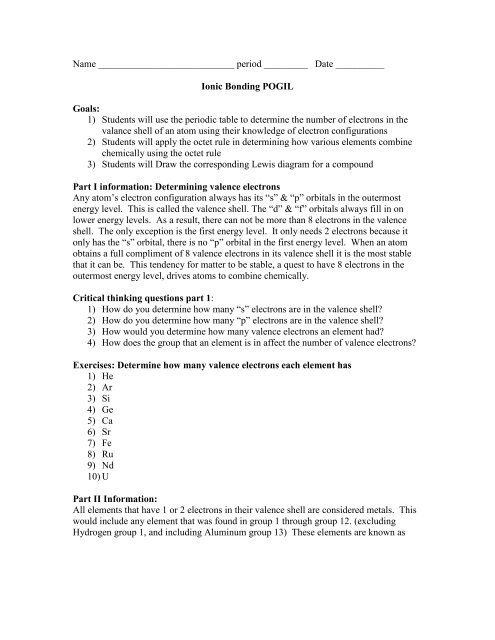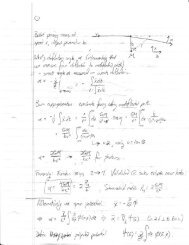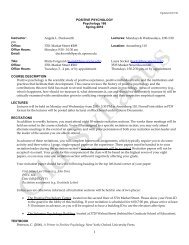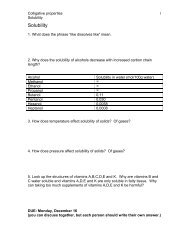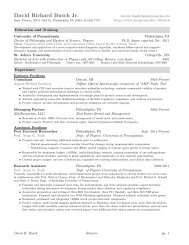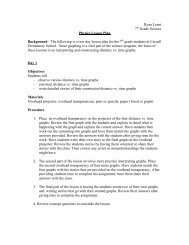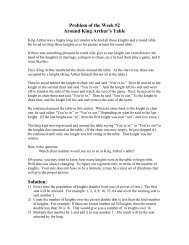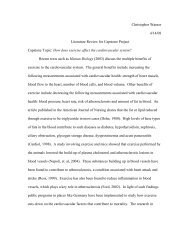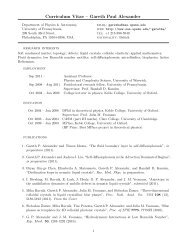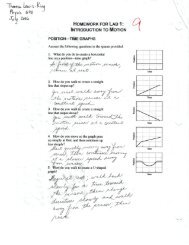Create successful ePaper yourself
Turn your PDF publications into a flip-book with our unique Google optimized e-Paper software.
Name ____________________________ period _________ Date __________<br />
Ionic Bonding <strong>POGIL</strong><br />
Goals:<br />
1) Students will use the periodic table to determine the number of electrons in the<br />
valance shell of an atom using their knowledge of electron configurations<br />
2) Students will apply the octet rule in determining how various elements combine<br />
chemically using the octet rule<br />
3) Students will Draw the corresponding Lewis diagram for a compound<br />
Part I information: Determining valence electrons<br />
Any atom’s electron configuration always has its “s” & “p” orbitals in the outermost<br />
energy level. This is called the valence shell. The “d” & “f” orbitals always fill in on<br />
lower energy levels. As a result, there can not be more than 8 electrons in the valence<br />
shell. The only exception is the first energy level. It only needs 2 electrons because it<br />
only has the “s” orbital, there is no “p” orbital in the first energy level. When an atom<br />
obtains a full compliment of 8 valence electrons in its valence shell it is the most stable<br />
that it can be. This tendency for matter to be stable, a quest to have 8 electrons in the<br />
outermost energy level, drives atoms to combine chemically.<br />
Critical thinking questions part 1:<br />
1) How do you determine how many “s” electrons are in the valence shell?<br />
2) How do you determine how many “p” electrons are in the valence shell?<br />
3) How would you determine how many valence electrons an element had?<br />
4) How does the group that an element is in affect the number of valence electrons?<br />
Exercises: Determine how many valence electrons each element has<br />
1) He<br />
2) Ar<br />
3) Si<br />
4) Ge<br />
5) Ca<br />
6) Sr<br />
7) Fe<br />
8) Ru<br />
9) Nd<br />
10) U<br />
Part II Information:<br />
All elements that have 1 or 2 electrons in their valence shell are considered metals. This<br />
would include any element that was found in group 1 through group 12. (excluding<br />
Hydrogen group 1, and including Aluminum group 13) These elements are known as
“electron givers”. In order to reach stability they surrender 1 or 2 electrons.<br />
Image found at: web.buddyproject.org/web017/web017/metals.html<br />
By surrendering electrons, the inner energy level that has eight electrons now becomes its<br />
valence shell<br />
Sodium atom with one valence electron<br />
Sodium atom when it loses an electron<br />
Notice that when the one electron is given away, it has the electron configuration of Neon<br />
a Nobel gas.<br />
The elements to the right of the diagonal line on the periodic table with the exception of<br />
group 18 are non-metals. These elements are known as electron takers in ionic bonding.<br />
Critical thinking questions part II<br />
1) Elements in group one would most likely give an electron to elements in what<br />
other group? ____________ Explain why: _______________________________<br />
__________________________________________________________________<br />
2) Elements in group 16 would most likely take electrons from elements in what<br />
other group? ____________ Explain why: _______________________________<br />
__________________________________________________________________
3) A single atom from group 16 would have to take electrons from how many atoms<br />
from group1? ___________ Explain why: _______________________________<br />
__________________________________________________________________<br />
4) Come up with a rule for the element groups and how they combine chemically?<br />
_____________________________________________________________________<br />
_____________________________________________________________________<br />
Exercises<br />
1) How many sodium atoms would be needed to bond with Chlorine? ___________<br />
2) How many sodium atoms would be needed to bond with Oxygen? ____________<br />
3) How many Calcium atoms would be needed to bond with Sulfur? _____________<br />
4) How many Calcium atoms would be needed to bond with Chlorine? ___________<br />
Part III Lewis Diagrams<br />
Lewis diagrams are a way to represent the valence electrons for an atom by placing dots<br />
around the chemical symbol to represent electrons. For instance: Chlorine has 7 valance<br />
electrons and Sodium has one valence electron. (see diagram below)<br />
From the diagram it is easy to see how the electron from sodium fits right in with the<br />
Chlorine atom. To bond Sodium with Oxygen you would need 2 Sodium atoms for every<br />
one Oxygen atom. (see diagram below) This type of bonding is called ionic bonding.<br />
When an atom gives away an electron it becomes positively charged, and when an atom<br />
takes an electron it becomes negatively charged. When the two atoms have opposite<br />
charges they are attracted to each other. This electrical attraction between two ions forms<br />
a chemical bond.
Critical Thinking questions part III:<br />
1) What groups would bond in a one to one ratio? Explain why: ___________________<br />
____________________________________________________________________<br />
2) What groups would bond in a two to one ratio? Explain why: ___________________<br />
____________________________________________________________________<br />
3) What groups would bond in a three to one ratio? Explain why: __________________<br />
___________________________________________________________________<br />
Exercises: Draw the Lewis diagram for the element<br />
1) F<br />
2) Li<br />
3) Mg<br />
4) Cl<br />
5) S<br />
6) K<br />
Draw the Lewis diagram when two atoms bond<br />
7) Li & F<br />
8) K & O<br />
9) Mg & Cl<br />
10) Mg & S


